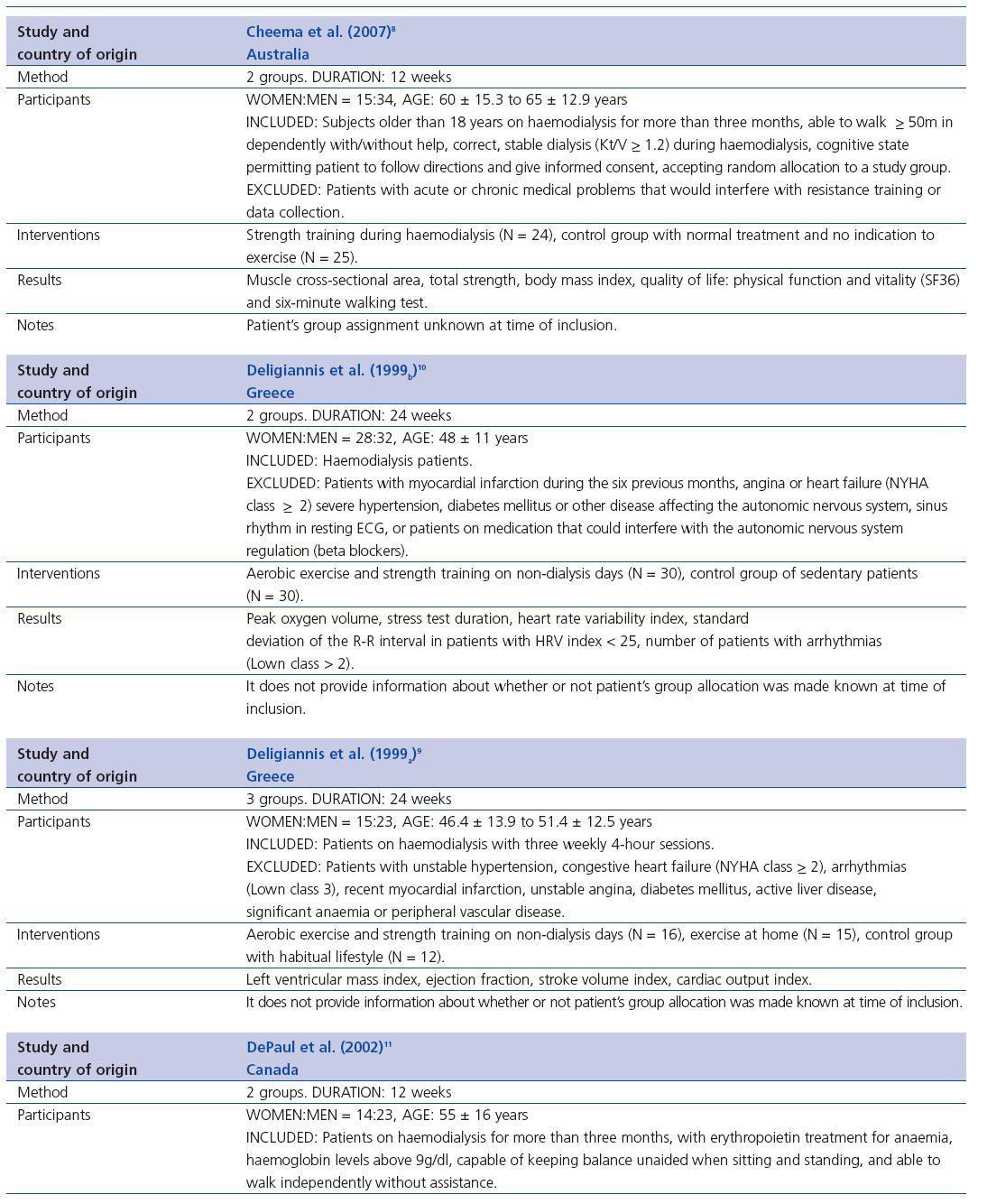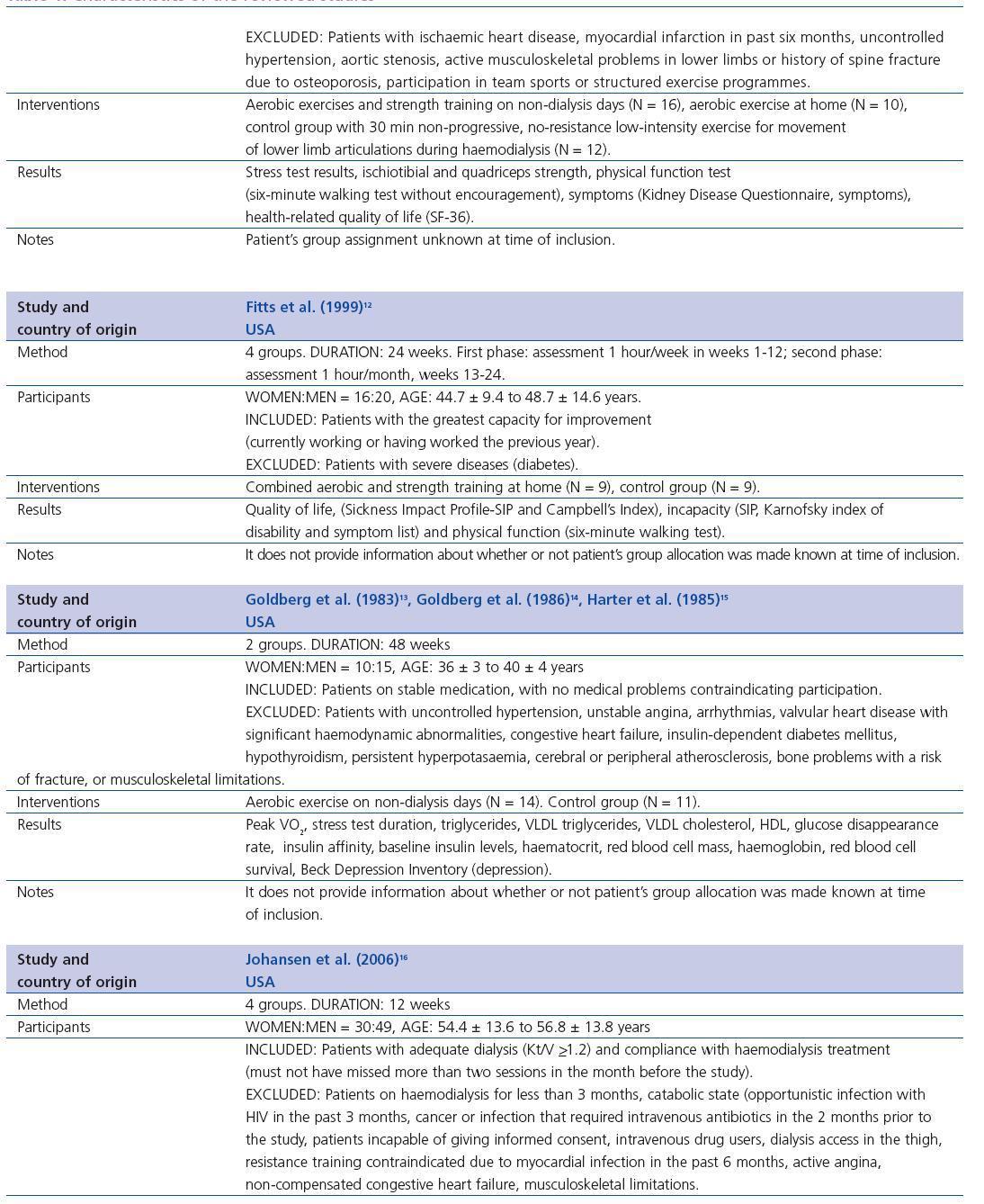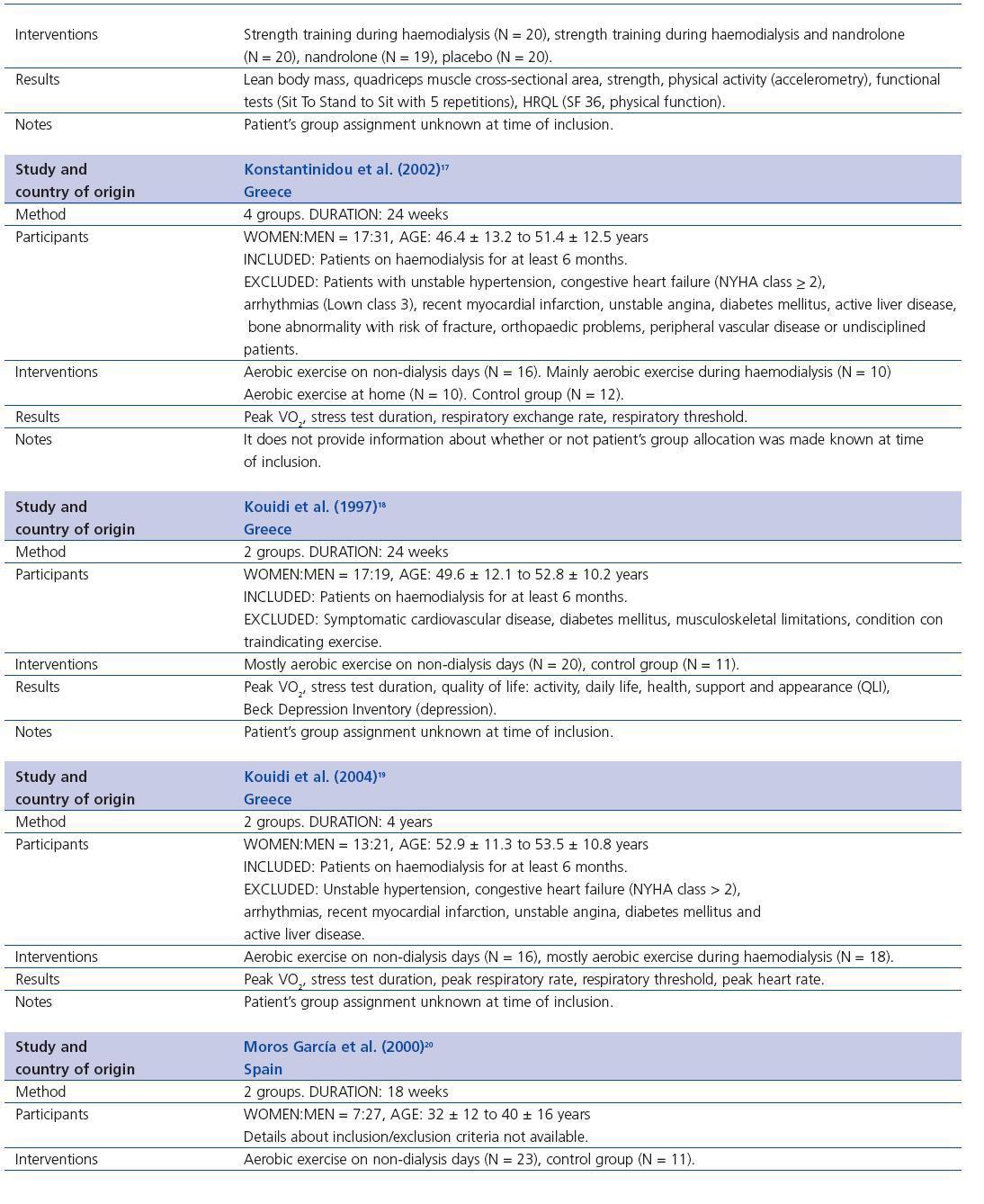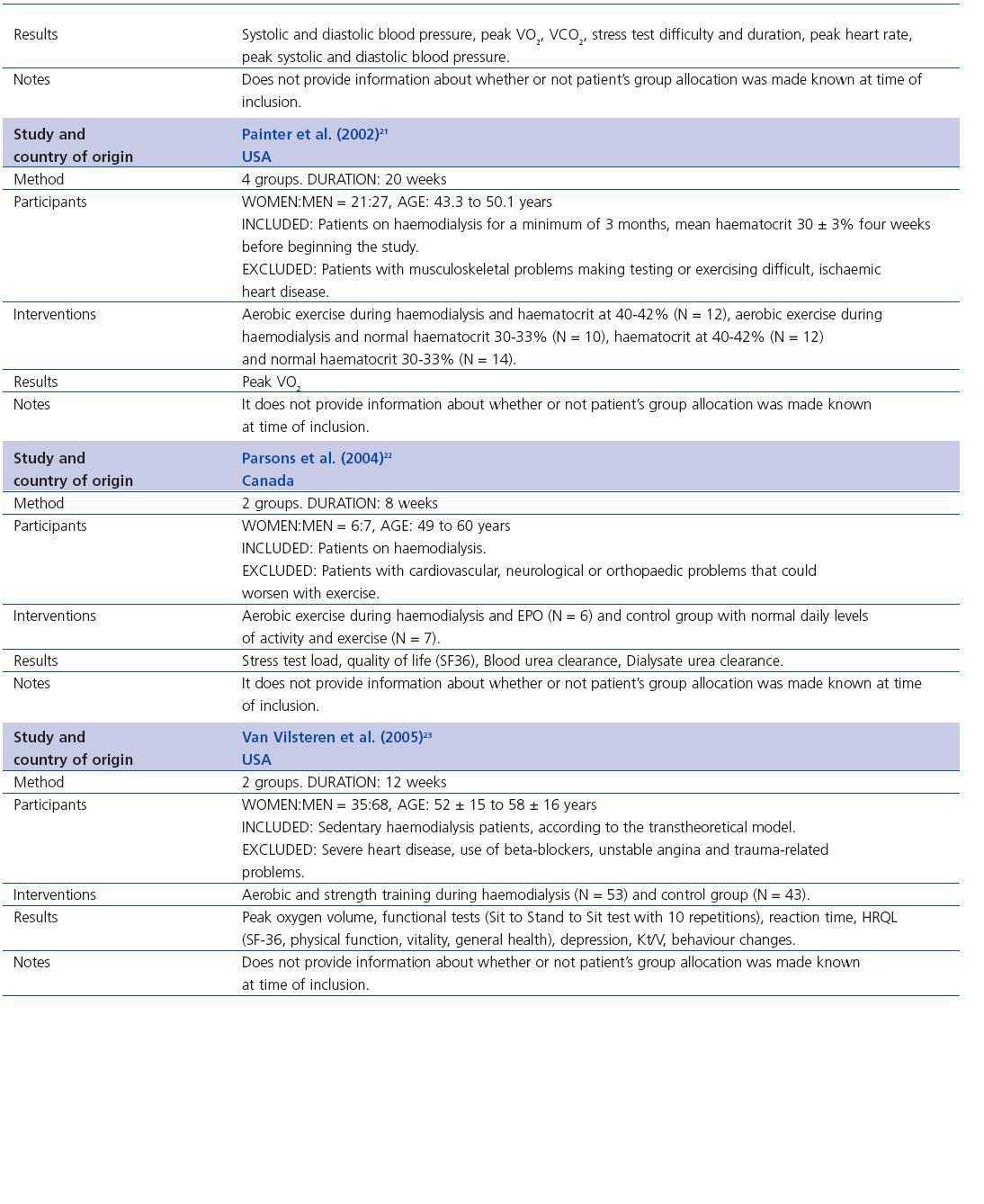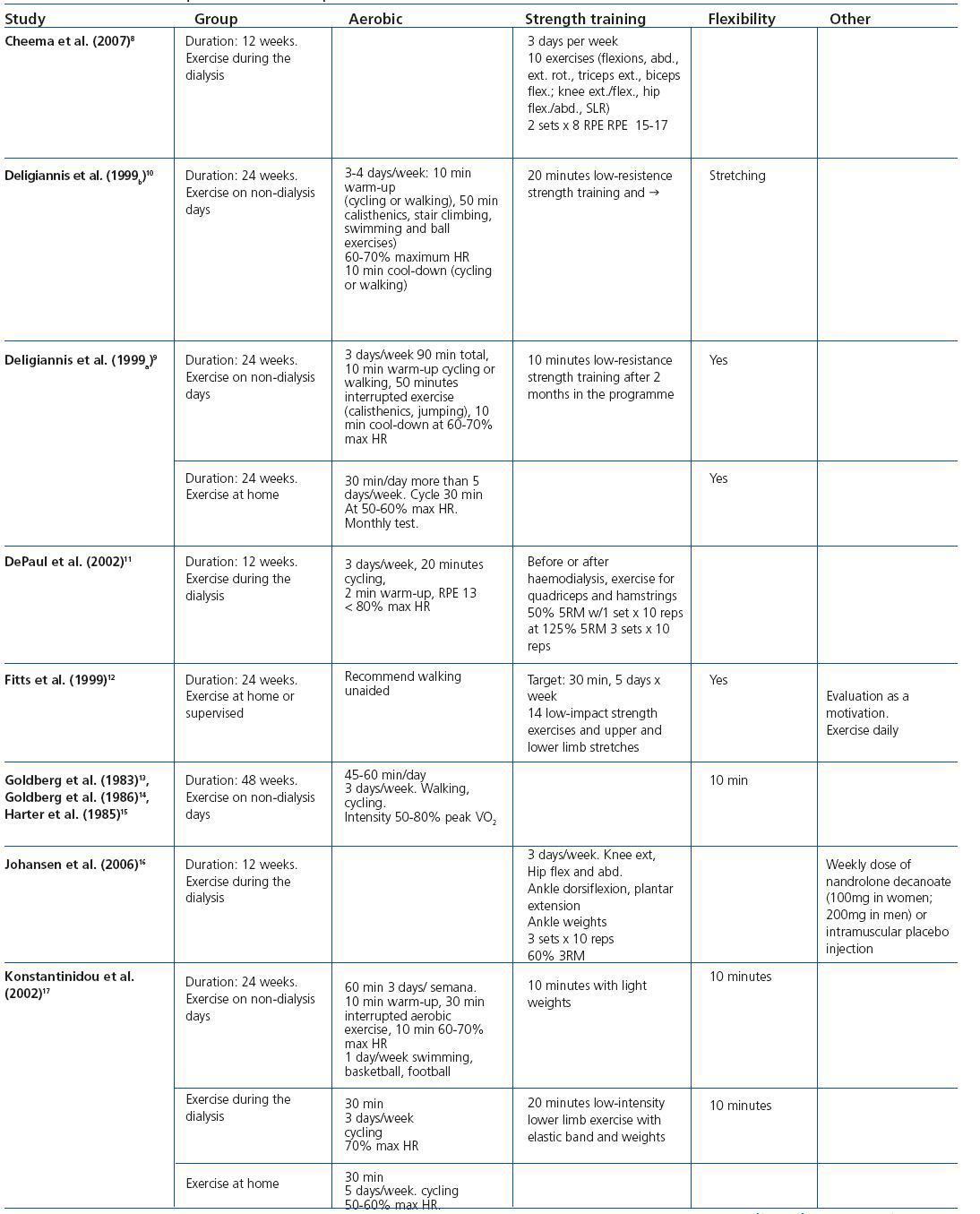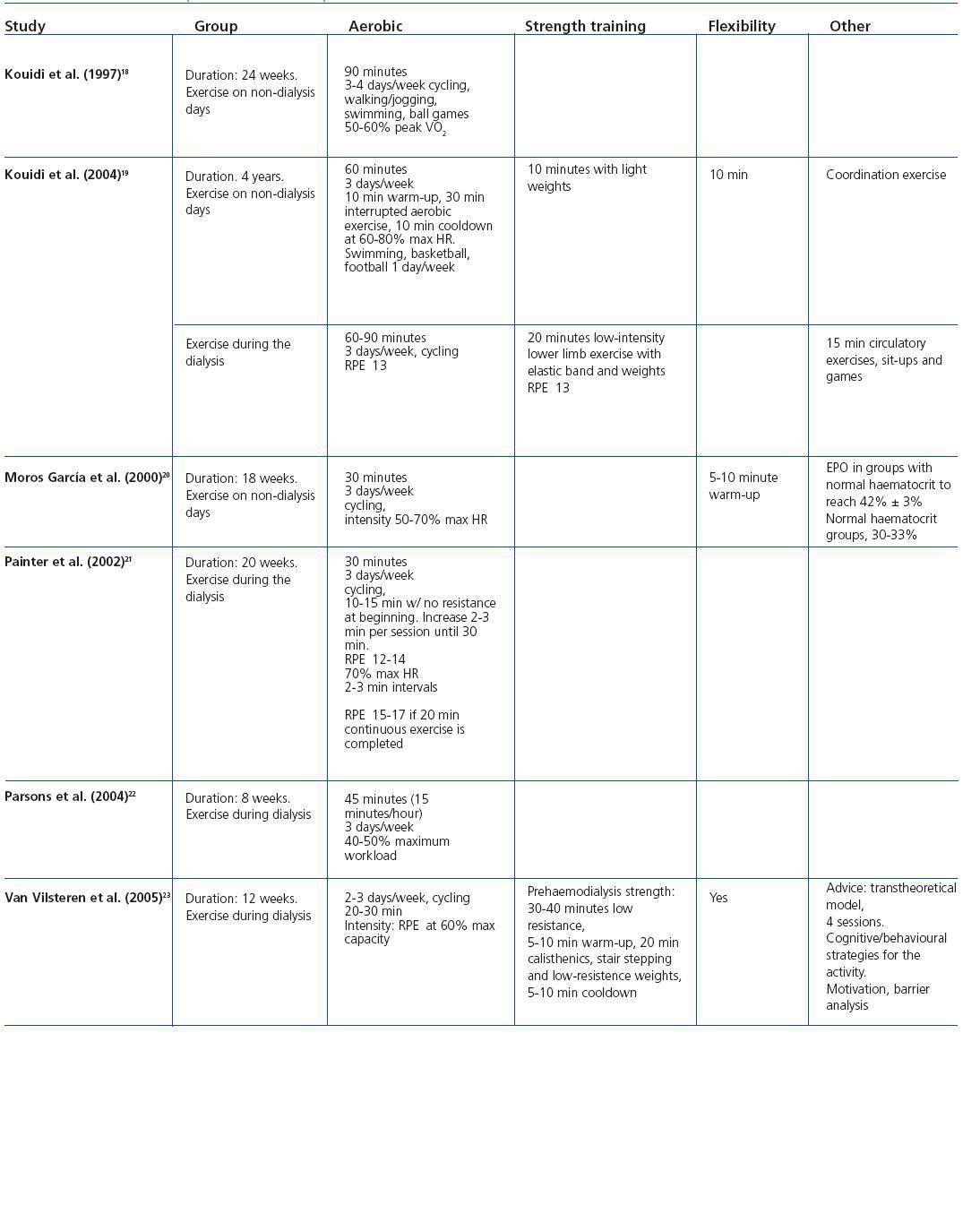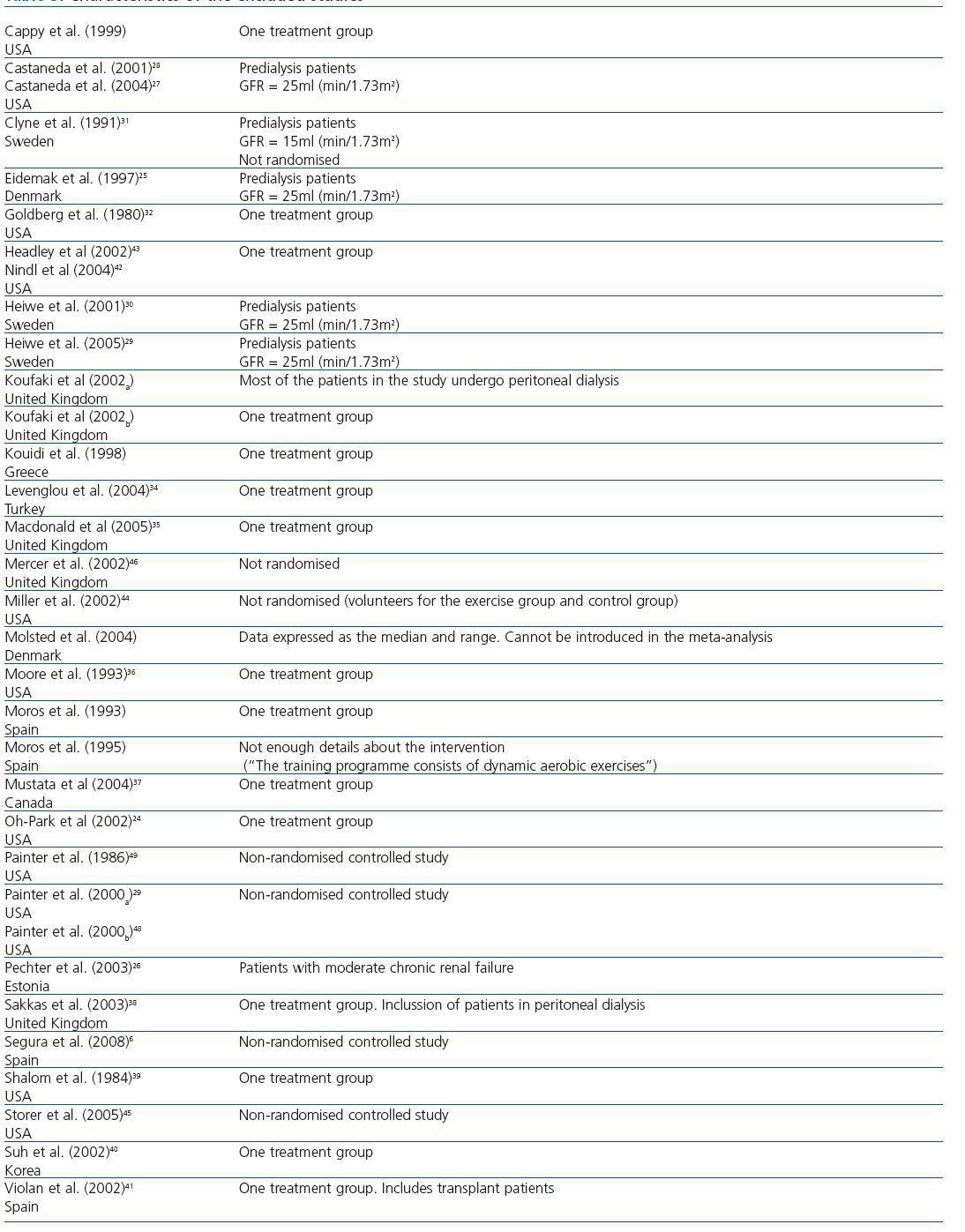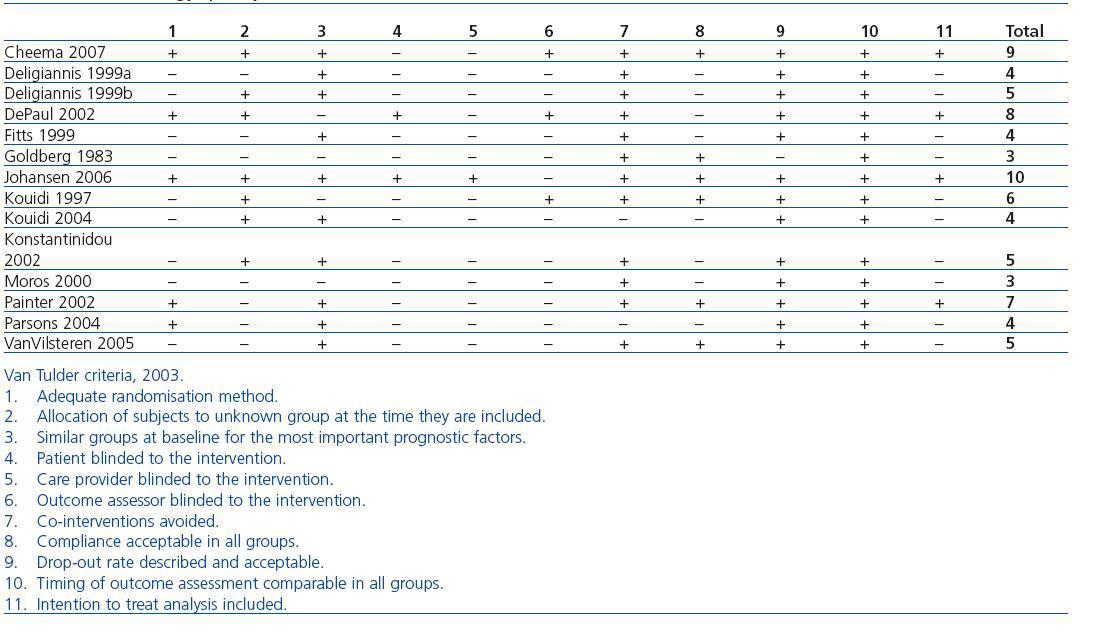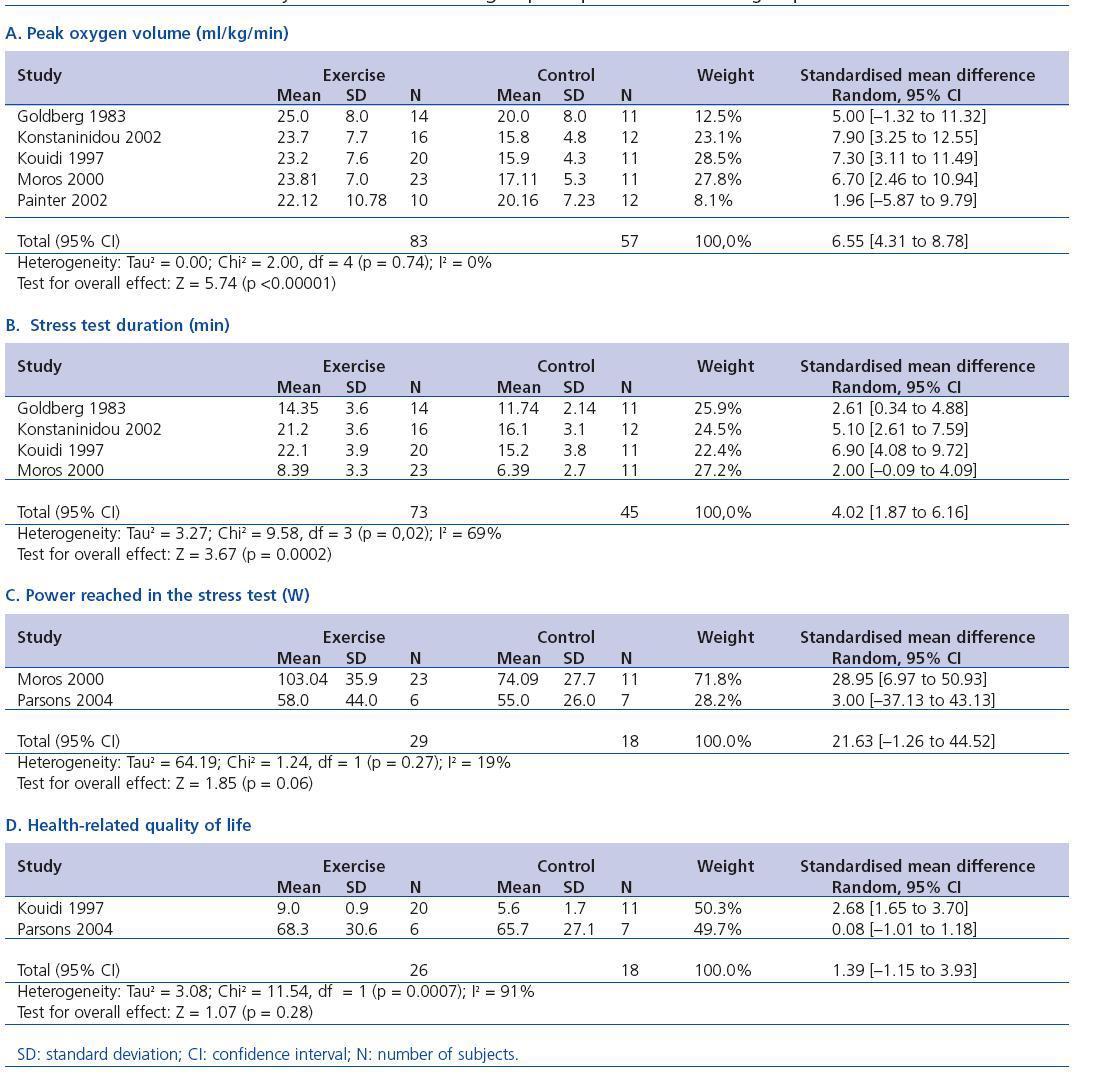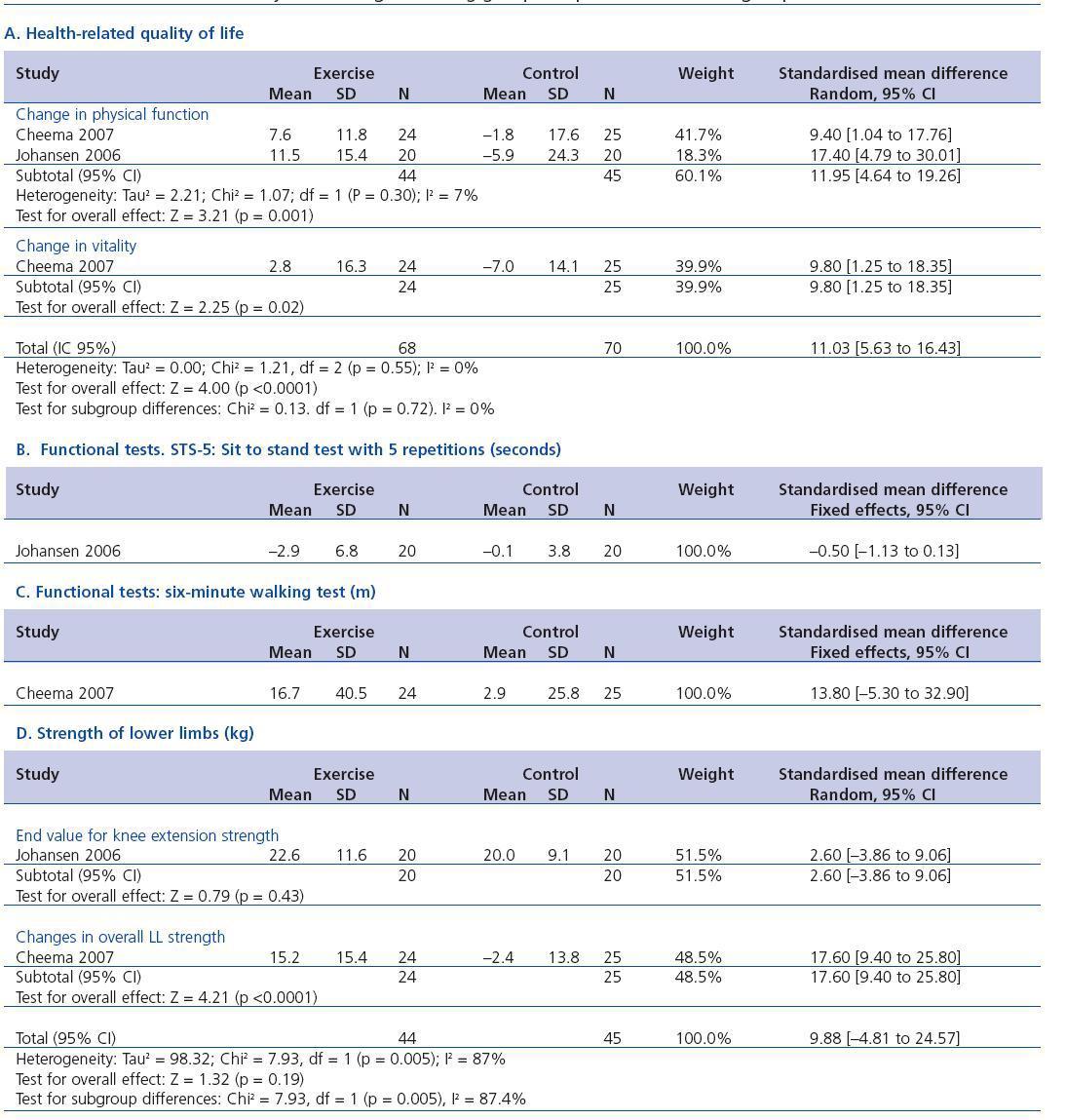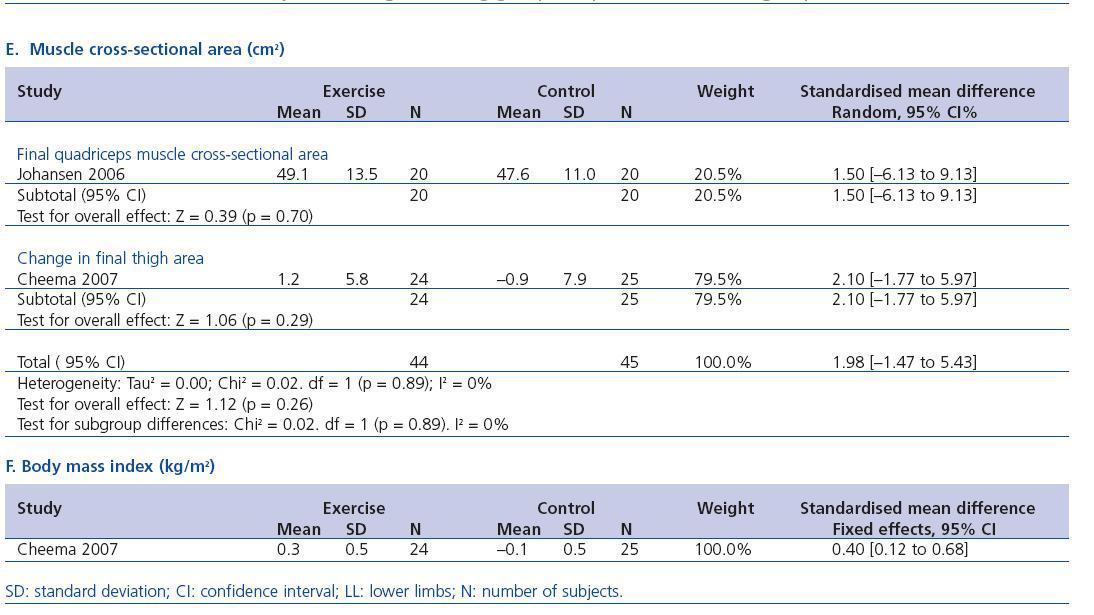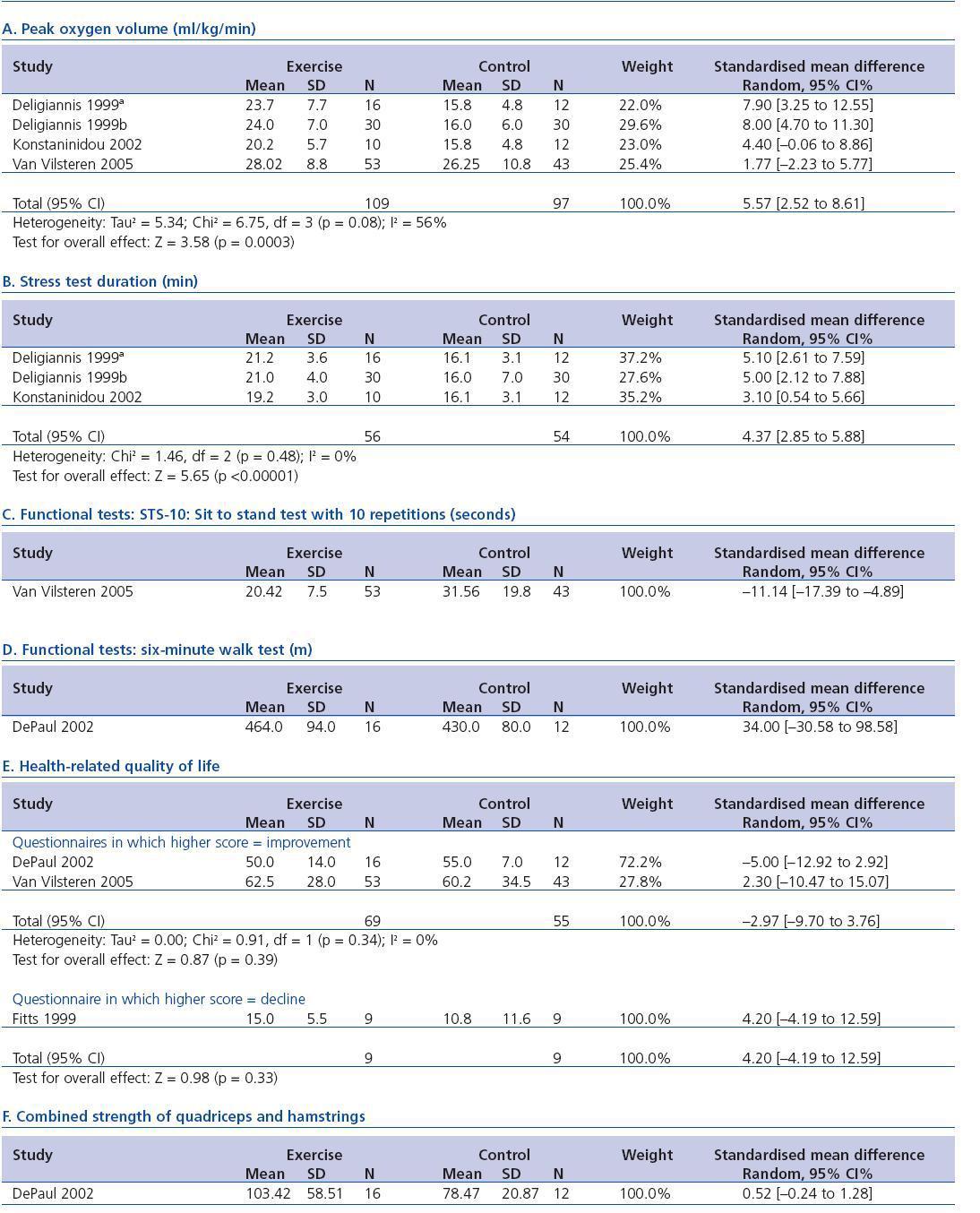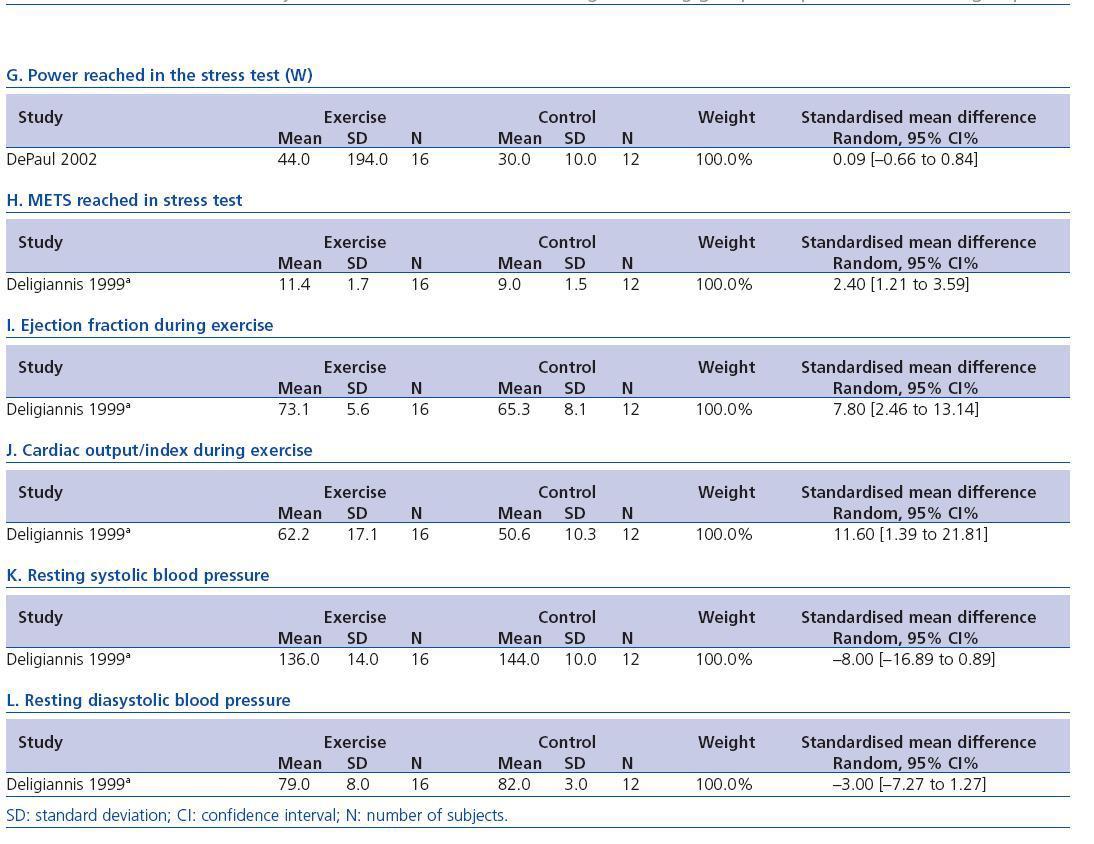Exercise as a therapeutic tool used in End-stage renal disease patients (ESRD) in hemodialysis (HD) is not routinately applied, as it occurs with cardiac or respiratory patients. Lack of awareness of research in this field may contribute to the current situation. Thus, the aims of this review are: 1) to systematically review the literature of exercise training on adult HD patients or patients at a pre-HD stage; 2) to show the evidence on the benefits of exercise for counteracting physiological, functional and psychological impairments found even in older ESRD patients; 3) to recommend requirements of future research in order to include exercise prescription in the HD patients treatment. The Data bases reviewed from 2005 to 2009 were: MEDLINE (Ovid), CINAHL (EBSCOHost), SportDicus (EBSCOHost), Academic Search Complete (EBSCOHost), Fuente Académica (EBSCOHost), MedicLatina (EBSCOHost), PEDro y PubMed. Additionally, references from identified articles, several reviews on ESRD and abstracts to Nephrology Congresses were also reviewed. Randomized Controlled Trials on aerobic, strength and combined programs for HD patients were selected. Data from the studies was compiled and Van Tulder criteria were used for methodological quality assessment. Metanalysis included 6 studies on aerobic exercise, 2 on strength exercise and 5 on combined exercise programs. 640 patients were included in 16 included studies. Effects on physical function, health related quality of life and other secondary measurements were summarized by the Standardized Mean Difference (SMD) Moderate evidence exists on positive effects of aerobic training on peak oxygen consumption at the graded exercise test (SMD 6.55; CI 95%: 4.31-8.78). There is high evidence on positive effects of strength training on health related quality of life (SMD 11.03; CI 95%: 5.63-16.43). Finally, moderate evidence exists on positive effects of combined exercise on peak oxygen consumption at the graded exercise test (SMD 5.57; CI 95%: 2.52-8.61). Summarizing, moderate evidence exists on the improvement on exercise capacity of aerobic training, isolated or combined with strength training. Strength training improves health related quality of life, functional capacity and lower limbs strength. Future studies should clarify which out of the three modalities results in higher benefits for HD patients.
El ejercicio como herramienta terapéutica en pacientes con enfermedad renal crónica en estadio V (ERC-V) en hemodiálisis (HD) no se está utilizando en la rutina de estos pacientes, como ocurre con cohortes con patología cardiaca o respiratoria. El desconocimiento de la investigación en este campo puede contribuir a ello. Por lo tanto, los objetivos de esta revisión son: 1) revisar sistemáticamente los estudios realizados en pacientes adultos en HD; 2) proporcionar evidencias de los efectos del ejercicio para contrarrestar el deterioro fisiológico, funcional y psicológico asociado con la ERC-V, incluso en pacientes de edad avanzada; 3) recomendar los requisitos de futuras investigaciones para conseguir la integración de la prescripción de ejercicio en la práctica médica en estos pacientes. Se efectuaron búsquedas en las siguientes bases de datos desde 2005 hasta 2009: MEDLINE (Ovid), CINAHL (EBSCOHost), SportDicus (EBSCOHost), Academic Search Complete (EBSCOHost), Fuente Académica (EBSCOHost), MedicLatina (EBSCOHost), PEDro y PubMed. Otras fuentes utilizadas fueron las listas de referencias de los artículos identificados por el revisor y revisiones sobre la ERC-V, así como resúmenes de congresos publicados. Se seleccionaron ensayos aleatorios que utilizaron el ejercicio aeróbico, de fuerza o la combinación de ambos en el tratamiento de pacientes en HD. Se extrajeron los datos de cada estudio y se evaluó la calidad metodológica según los criterios de Van Tulder. Sólo se pudo aplicar el metaanálisis en los resultados de 6 estudios con ejercicio aeróbico, 2 estudios con ejercicio de fuerza y 5 estudios con ejercicio combinado. Hubo un total de 640 sujetos en los 16 estudios incluidos. Los efectos de los distintos tipos de ejercicio en pacientes en HD sobre la función física, calidad de vida y otras medidas de interés se resumieron mediante el cálculo de la diferencia de medias estandarizada (DME). Hay pruebas de calidad moderada de que el entrenamiento aeróbico produce efectos positivos el consumo pico de oxígeno en la prueba de esfuerzo (DME 6,55; intervalo de confianza [IC] 95%, 4,31-8,78). Existe evidencia alta de que el entrenamiento de fuerza posee un efecto positivo sobre la calidad de vida relacionada con la salud (DME 11,03; IC 95%, 5,63-16,43). Por último, hay pruebas moderadas de que el entrenamiento combinado produce efectos positivos sobre el consumo pico de oxígeno en la prueba de esfuerzo (DME 5,57; IC 95%, 2,52-8,61). En conclusión, existen evidencias moderadas de que el ejercicio aeróbico, aislado o combinado con ejercicio de fuerza, mejora la capacidad de ejercicio, y de que el ejercicio de fuerza mejora la calidad de vida, la capacidad funcional del sujeto y la fuerza de los miembros inferiores. Futuros estudios deberán responder a la pregunta de qué tipo de ejercicio, aeróbico, resistido o combinado, es el más beneficioso para los pacientes en HD.
INTRODUCTION
The number of patients with end-stage renal disease (ESRD) undergoing haemodialysis treatment (HD) grows year by year, as shown by an increase of more than 67% in the number of HD sessions performed in Spain in 2004 compared with data from 1999.1 Between 1991 and 2000, the number of patients on dialysis in Spain grew by nearly 38%.2 The rate of HD use per 1,000 inhabitants per year as of December 2007 was 37.38.3 Most patients with ESRD are treated with HD, as indicated by 2004 data from Catalonia, where 49.7% of the patients received HD as renal replacement therapy, while 47.3% of the patients underwent transplantation and 3.1% received peritoneal dialysis.4 The most common dose for HD is four hours three days a week. This is administered during the patient’s entire life until he/she receives a transplant, in case of being a candidate. Despite advances in HD treatment, HD does not ensure optimum Health related quality of life (HRQoL). Therefore, patients on HD experience a significantly lower HRQL compared to their healthy counterparts or patients who have undergone transplantation.5 In the early 1980s, countries such as the United States began implementing physical exercise programmes during HD. Since then, studies report exercise-related benefits for these patients on the physiological, functional and psychological levels. The common objective of such studies is to improve an HRQL, which has decayed due to a treatment that relegates increasingly older patients to a sedentary lifestyle, with a disease accompanied by protein catabolism and anaemia. After 30 years of research on the effects of long-term exercise in HD patients, it seems that exercise is safe, and that exercise during HD is the way to achieve the highest patient compliance. Despite everything, implementation of exercise programmes in HD units is not widespread in most countries. If we analyse Spain in particular, we find only a few studies. A literature review shows that few projects implemented exercise programmes exclusively for HD patients, and only one of these studies,6 published in 2008, addressed exercise performed during the HD session. Various factors may explain Spain’s lack of implementation of exercise during HD. This country is ranked number one in transplants, and this could explain why studies of mostly elderly patients with high co-morbidity rates, who are not transplant candidates, would play a secondary role. This is so much the case that we do not observe this type of programme for patients undergoing chronic HD, even though exercise programmes are being implemented for patients with heart or pulmonary disease. In addition, HD patients incur significant health costs from the renal replacement therapy, medication and hospital admissions arising from their high co-morbidity rates, which can limit any added investment in physical therapy through therapeutic exercise. Lastly, the lack of clinical practice guidelines based on the synthesis of quality research results in this area may also have led to lack of clinical use of such an approach. With this in mind, our study has the following objectives: 1. Systematically review the studies of physical exercise in adult patients on HD. 2. Provide evidence for exercise’s effect in combating the physiological, functional and psychological deterioration associated with ESRD, including in elderly patients.
METHODOLOGY: EVALUATION CRITERIA FOR STUDIES IN THIS REVIEW
Types of study
We selected randomized clinical trials (RCTs) comparing an intervention that included an exercise component with a control group (without exercise, or with very low-intensity exercise equivalent to a placebo), interventions with no exercise, or interventions with different types of exercise in HD patients. Studies were included if the authors used the word “random” to describe the method for assigning subjects to groups.
Type of participants
Subjects were all adults (older than 18 years) undergoing HD treatment for ESRD.
Type of intervention
Exercise was defined as planned, structured movement undertaken to improve or maintain one or more aspects of physical fitness (ACSM, 2001). Interventions were classified according to the type of exercise in the main phase, without taking warm-up and cool-down into account. They were therefore categorised as aerobic, strength training, or combined strength training and aerobic exercise. Once it was established that the intervention worked with these components, no restrictions were made based on the frequency, intensity or duration of the exercise programmes. The interventions could take place during the HD session, on non-dialysis days with supervised groups, or take the form of exercise at home without direct supervision.
Types of result measurement
Result measurements did not form part of the inclusion criteria in this review. Result measurements were categorised as primary results (physical function and HRQL) and secondary results, which represented other aspects that are frequently affected in patients with ESRD.
Primary result measurements
Physical function
1. Objective laboratory measurements of aerobic capacity: cycloergometer testing (peak oxygen consumption, time, power output, METs).
2. Physical function tests: Daily life activity testing (walking during six-minute walking test).
3. Muscular function and morphology measurements: dynamometry of lower limbs and muscle cross-sectional area.
4. HRQL(with generic questionnaires such as SF-36, Sickness Impact Profile or the Quality of Life Index, or the specific questionnaire for kidney patients, the Kidney Disease Questionnaire).
Secondary result measurements
1. Effects on cardiac function (ejection fraction, cardiac output, resting systolic and diastolic blood pressure).
2. Depression (Beck Depression Inventory).
3. Body mass index.
SEARCH STRATEGY FOR IDENTIFYING STUDIES
Searches using English terminology were performed between February 2005 and February 2009 in the following databases: MEDLINE (Ovid), CINAHL (EBSCOHost), SportDicus (EBSCOHost), Academic Search Complete (EBSCOHost), Fuente Académica (EBSCOHost), MedicLatina (EBSCOHost), PEDro and PubMed. The search terms we used were as follows: end stage renal disease, haemodialysis, exercise, physical function, resistance training, exercise test, quality of life, muscle strength, physiotherapy, randomized controlled trial, physioth*, or exercis*. Reference lists from the articles identified by the reviewer, reviews regarding ESRD and published conference summaries were also used.
REVIEW METHODS
Study selection
The reviewer (E.S.O.) explored the titles and summaries turned up by the searches. Reference lists from the revised articles were also examined, and summaries followed by the full articles were compiled. The review only includes fulltext articles in English or Spanish.
Evaluation of methodology quality in studies
The study used Van Tulder7 methodology quality criteria, which consider adequate randomisation, concealed treatment allocation at time of inclusion, groups similar at baseline for the most important prognostic factors, patient, care provider and outcome assessor blindness to the intervention, avoidance of co-intervention, acceptable compliance, described and acceptable drop-out rate, comparable outcome assessment timing in all groups and inclusion of an intention to treat analysis. Its maximum possible score is 11.
Treatment effect measurements
Exercise capacity, functional physical tests, muscle function and HRQL were the variables considered to be outcome measurements. They are shown as the mean and standard deviation. RevMan Analysis software version 5 was used to calculate the standard mean difference (SME). When different measurement tools are used to measure the same result, this programme enables conversion of the different scales to a common mean. The meta-analysis included only those studies comparing an exercise group to an untreated control group.
Heterogeneity evaluation
We evaluated heterogeneity from trial to trial using heterogeneity statistics (χ2 test). P-values lower than or equal to 0.1 were considered indicative of significant heterogeneity. In this case, a meta-analysis was performed with a random effects model.
Data synthesis (meta-analysis)
The mean change scores were compared using RevMan Analysis software, version 5. We used the following descriptor levels for the Van Tulder7 criteria to classify the meta-analysis results: 1. High level of evidence: consistent findings in multiple high-quality RCTs. 2. Moderate evidence: consistent findings in multiple low-quality RCTs or controlled clinical trials, or in one high-quality RCT. 3. Limited evidence: one low-quality RCT. 4. Contradictory evidence: Inconsistent findings in multiple trials (RCTs). 5. No evidence from trials: no RCTs. “Clearly favours” applies in the case of a confidence interval that excludes zero.
DESCRIPTION OF STUDIES
Results of the search
We found a total of 49 studies describing experimental trials that examined the effects of interventions that included some type of exercise in patients with chronic kidney disease. Of these studies, 42 were carried out on HD patients, and 22 were controlled randomised studies.
Included studies
Sixteen studies met the inclusion criteria.8-23 One article13 was complemented by two subsequent studies that examined the same topics,14,15 and the set of three was considered as a single study in the analysis (14 total studies). Table 1 shows a summary of these studies. Of the total studies, eight compared an exercise programme with a control group,8,10,12,13,18,20,22,23 while other studies also compared supervised exercise on non-dialysis days with exercise during the HD session9,19 or even included another group exercising at home.17 The use of a placebo exercise intervention appears in only one of the studies.11 Painter et al.21 added two groups with EPO or EPO plus exercise. A recent study16 compared the effect of exercise with taking nandrolone with or without exercise. Statistical analysis between the groups was performed in eleven studies,8-12,16- 19,21,23 while analysis was performed before and after an intragroup intervention in three studies.13,20,22
Subjects
Sample size
The 14 reviewed studies included a total of 640 patients. The smallest sample size included 13 patients, while the largest included 103. Only one study included more than 100 patients.23
Sex
The patient total included 244 women and 396 men. All of the articles we reviewed indicated the sex of the participants, and all included both male and female subjects.
Age
Age of included participants, expressed as a mean ± standard deviation, ranged between 32 ± 12 years20 and 65 ± 12.9 years8. The youngest patient was 19 years old13 while the oldest16 was 88.
Haemodialysis duration
A common inclusion criterion for most of the studies was that subjects had been on HD for at least three months. Data for time on HD showed a maximum mean time of 84 months (7 years)19 and a minimum mean time of 29.6 months on HD treatment.12 Only one study expressed this data as a range, which appeared as a minimum time of 3 months on HD and a maximum time of 288 months (24 years).16 The ample range and high standard deviation of the samples show the high degree of variability for time on HD among subjects included in exercise programmes.
Aetiology
Only four of the studies indicated kidney disease aetiology of participating subjects.8,13,21,22 The main causes of kidney disease are glomerulonephritis, hypertension, polycystic renal disease and diabetes. Two studies excluded patients with diabetes.18,19
Comorbidity
Eight of the studies provided information about comorbidities in the samples. The mean prevalence of the most common diseases in these study samples was as follows: hypertension 78.8% (231 of 293 patients), cardiovascular disease 32.4%, diabetes 22.9% and peripheral vascular disease 4.1%. We note a high prevalence of hypertension in three studies in which the condition affected between 87.5 and 100% of included patients.8,16,17
Exercise programmes
The results of this section are summarised in table 2.
Duration
Programme duration varied between two months22 and four years.19 Exercise programmes lasted between three and six months in 90% of the studies. Only two studies created longer-duration programmes with interventions during 12 months13 and even four years, in the case of the longest study to date.19
Type and frequency
Most of the study interventions took the form of aerobic exercise (8/14, 57%).12,13,17-22 A stationary bicycle was used in all cases except for the study by Fitts12 in which patients walked. In most articles, cycling was combined with walking, jogging, fitness ball exercises, swimming and basketball, while in two of the studies exercise was based exclusively on a cycling workout21,22. Interventions with combined aerobic exercise and progressive-resistance strength training (4/14, 29%) consisted of adding lowintensity lower limb strengthening exercises to the aerobic workout, and upper limb exercises were only carried out in one study.12 Exercise in the exclusive form of progressive resistance strength training (2/14, 14%) was the most uncommon. Only two studies had HD patients perform this type of exercise for the lower limbs,8,16 and only one study also included upper limb strength training.8
Frequency and intensity
Session frequency was three times per week. Studies that applied isolated or combined aerobic programmes used moderate intensity programmes. Therefore, exercise intensity varied between 50 and 80% of the VO2 peak volume calculated using a stress test.13,18 Other programmes regulated intensity according to peak heart rate, which varied between 50 and 80%.9-11,17,19-21 Lastly, other less commonly used parameters for regulating intensity were the rate of perceived exertion scale19 and the maximum workload reached in the stress test.22,23 One of the studies relying solely on progressive resistance strength training applied high levels of resistance in series with few repetitions, reaching a perceived exertion of 15 to 17 on a scale of twenty.8 The other study used moderate resistance in 10-repetition series with the load at 60% 3 RM.16
Supervision
All of the studies indicate that exercise programmes were supervised by qualified health professionals, except for two articles that do not provide data about whether or not exercise programmes were supervised.20,23 In the three articles in which the exercise programme was carried out at home,9,12,17 there was no direct supervision, but regular contact was maintained with the patients.
Compliance
Four articles (4/14, 29%) provided information about the participants’ rate of compliance with the programme, generally expressed as the percentage of sessions attended out of the total offered. The compliance rate in these articles ranges between 76%11 and 91%.23
Adverse effects
Only four of the articles explicitly state that there were no adverse effects resulting from participation in exercise programmes.8-10,17
Outcome measurements
Various methods for measuring outcome were used to evaluate physical function. Aerobic capacity was measured in four different ways depending on the study. We find it measured by the peak oxygen consumption reached in the cycloergometer test in nine of the fourteen studies; the total exercise time in seven studies; the power output reached in three studies, and the METs attained in one study. Muscle strength was measured in three studies, and muscle crosssectional area in two. Functional physical tests were used in four studies, two of which employed the six-minute walking test, while the other two used the sit to stand test. Healthrelated quality of life was measured in 7 studies, using different tools. SF-36 was used in three of these studies, while another two used the Quality of Life Index, another used the Kidney Disease Questionnaire and the last, the Sickness Impact Profile.
Excluded studies
A total of 33 studies were excluded. Table 3 lists the reasons for their exclusion. Seven of the studies we found (14%) included patients with moderate chronic kidney disease in a pre-dialysis stage.25-31With regard to design, 16 (33%) of the 49 studies we found were experimental with no control group, and 11 (22%) were control studies without randomised distribution. With respect to studies without a control group, the intervention consisted of an aerobic exercise programme in ten studies (all but one of which indicated cycling exercise),32-41 progressive resistance strength training plus aerobic exercise (combined programme) in four studies, and strength training only in two.42,43 Variables were measured before and after the programme in all cases. Only five of the eleven studies (45%) with a control group and without randomised distribution presented a statistical analysis for different groups,44-48 while the rest presented an intragroup analysis only.6,26,29-31,49
METHODOLOGICAL QUALITY
The mean Van Tulder quality score was 5.5 (out of 11). Scores for individual studies ranged from 3 to 10. Four studies were categorised as high quality, four were average quality and six were poor quality. The item-by-item breakdown for the methodology evaluation is shown in Table 4. Only five studies describe randomisation by groupings that take into account factors such as subjects’ age and sex. Six of the studies indicate concealed treatment allocation. Most of the studies describe the baseline similarity of principal prognostic factors among the different groups. Only two cases have a subject blinded to the intervention. The first case used a placebo intervention11 and the second case is an intervention that combines exercise with a drug substituted with a placebo in the control group.16 For this reason, the second study manages to have the care provider blinded to the intervention, but in other cases with interventions that require following an exercise programme, this is not possible. Only three studies indicate that a blinded outcome assessor measured the intervention results. Nearly all of the studies managed to avoid co-intervention. Only six studies met the criterion of compliance, sometimes due to lack of information on this topic. Virtually all of the studies describe an acceptable drop-out rate, and measure all groups at a similar time. The criterion of including an intention to treat analysis was only met in four studies.
RESULTS
Following the preliminary analyses of heterogeneity and methodology quality, we performed the meta-analyses using data from the effect of exercise on aerobic capacity, functional physical capacity, strength and HRQL for aerobic exercise only, for strength training only, and for exercise combining aerobics and strength training, all of which were compared to an untreated control group. The results show the data from the studies that were included, the weight for each study, the standard mean difference (SMD) with confidence intervals, and the heterogeneity analysis for the studies.
Meta-analysis for the aerobic exercise intervention groups compared with untreated control groups
Moderate evidence exists to the effect that short-term (8 to 24 week) aerobic exercise training produces the following (table 5):
1. Large positive effects on peak oxygen consumption in the stress test: although grouping data from 140 subjects showed this effect, SMD 6.55 (95% confidence interval [CI], 4.31-8.78), the only high-quality study21 demonstrated a large positive effect which was not significant, as did one low-quality study.13 However, two average quality studies17,18 and one low-quality study20 did show large, statistically significant positive effects.
2. Large positive effects on exercise time in the stress test: SMD 4.02 (95% CI 1.87-6.16) with 118 grouped subjects from four studies, including one poor quality13 and two average quality studies.17,18 The other lowquality study20 found a large positive effect, but it was not significant.
3. Large but not significant effects on the power output reached in the stress test: SMD 21.63 (95% CI, -1.26 to 44.52) with 47 grouped subjects in a poor-quality study20 which found a large significant positive effect, and another low-quality study22 which found a large positive effect that was not significant.
4. Large but not significant positive effects on the healthrelated quality of life according to the Quality of Life Index: SMD 1.39 (95% CI, –1.15 to 3.93) with 44 grouped subjects in an average-quality study18 and a lowquality study.22
Meta-analysis for the strength training intervention groups compared with untreated control groups
Considerable evidence exists to the effect that in the short term (12 weeks), strength training produces the following (Table 6):
1. Large affect on the health-related quality of life (measured with the SF 36 questionnaire): SMD 11.03 (95% CI, 5.63-16.43) with 89 subjects in two highquality studies for the physical function subscale8,16 and one high-quality study with 49 subjects for the vitality subscale.8
Moderate evidence exists to the effect that in the short term (12 weeks), strength training produces the following:
1. Medium-sized but not significant positive effects on functional tests (sit to stand test with five repetitions): SMD –0.50 (95% CI, –1.13 - 0.13) with 40 subjects in a high-quality study.16
2. Large but not significant positive effect on the functional six-minute walking test: SMD 13.80 (95% CI, –5.30 to 32.90) with 49 subjects in a high-quality study.8
3. Large but not significant positive effect on lower limb strength: SMD 9.88 (95% CI, –4.81 - 24.57) with 79 subjects grouped in a high-quality study8 that found a sizeable, statistically significant positive effect on extensors of the knee, hip abductors and triceps surae, while another high-quality study16 found a large but not significant positive effect on quadriceps strength.
4. Large but not significant positive effect on the quadriceps muscle cross-sectional area: SMD 9.88 (95% CI, –4.81 - 24.57) with 79 subjects in two high-quality studies.8,16
5. Positive small to medium effect on body mass index: SMD 0.40 (95% CI, 0.12 - 0.68) with 49 subjects in a high-quality study.8
META-ANALYSIS FOR THE INTERVENTION GROUPS WITH COMBINED AEROBIC AND STRENGTH TRAINING COMPARED WITH UNTREATED CONTROL GROUPS
Moderate evidence exists to the effect that short-term (12 to 24 week) aerobic exercise training produces the following (table 7):
1. Large positive effects on peak oxygen volume in the stress test: although grouping data from the 206 subjects showed this effect, SMD 5.57 (95% CI, 2.52-8.61), only one average-quality study10 and another poor-quality study9 found this large positive effect to be significant. On the other hand, two moderate-quality studies17,23 also found this large positive effect, but it was not significant.
2. Large positive effects on exercise time in the stress test: SMD 4.37 (95% CI 2.85-5.88) with 110 grouped subjects from two average-quality studies10,17 and one poor-quality study.9
3. Large positive effects on functional tests: sit to stand test with 10 repetitions, significant in 97 subjects, SMD - 11.14 (95% CI, –17.39 - –4.89) in an average-quality study;23 six-minute walking test, not significant in 28 subjects, SMD 34.00 (95% CI, –30.58 to 98.58) in a high-quality study.11
There is contradictory evidence as to the effect of short-term (12 to 24 week) training with combined exercise on HRQL:
1. Large but not significant negative effect: SMD –2.97 (95% CI, –9.70 - 3.76) with 124 grouped subjects in an high-quality study11 and an average-quality study.23
2. Large but not significant positive effect in a poor-quality study with 18 subjects, SMD 4.20 (95% CI, –4.19 - 12.59).12
There is limited evidence from one high-quality11 and one low-quality study9 suggesting that 12 weeks of combined aerobic and strength training in HD patients produces:
1. Medium-sized but not significant positive effect on lower limb strength: 28 subjects, SMD 0.52 (95% CI, –0.24 - 1.28).11
2. No effect on power output reached in the stress test: 28 subjects, SMD 0.09 (95% CI, –0.66 - 0.84).11
3. Large and significant positive effect on METs reached in the stress test: 28 subjects, SMD 2.40 (95% CI, 1.21 - 3.59).9
4. Large and significant positive effect on ejection fraction during exercise: 28 subjects, SMD 7.80 (95% CI, 2.46 - 13.14).9
5. Large and significant positive effect on cardiac output index during the exercise: 28 subjects, SMD 11.60 (95% CI, 1.39 - 21.81).9 6. Large but not significant effect on resting systolic blood pressure: 28 subjects, SMD -8.00 (95% CI, –16.89 - 0.89).9 7. Large but not significant effect on resting diastolic blood pressure: 28 subjects, SMD -3.00 (95% CI, –7.27 - 1.27).9
DISCUSSION
Aerobic exercise
A total of six articles were included in the meta-analysis, which compared aerobic exercise protocols with an untreated control group. They included one high-quality,21 two medium-quality17,18 and three poor-quality studies.13,20,22 First, with respect to the primary outcome measurements, we found moderate-quality evidence of a large positive effect on peak oxygen consumption13,17,18,20,21 and exercise time in the stress test.13,17,18,20 Likewise, there was moderate evidence of aerobic exercise’s large positive effect on health-related quality of life.18,22 Most of the articles were rated low-quality, which must be taken into account when considering the benefit of aerobic exercise. Furthermore, patients included in the aerobic exercise studies were relatively young, and their mean age did not exceed 60 years in any of the studies. Even so, it seems clear that this type of exercise increases exercise capacity in patients on HD. This is a very important consideration, since it means increased independence and daily life function for these patients. Future studies on the effect of aerobic exercise should focus on patients older than 60 years and patients with a low functional capacity. Including functional tests to measure exercise programme results will make it easier for patients and researchers to carry out those tests. Lastly, the quality criteria set forth in this review or similar ones must be followed in order to increase evidence on the effect of exercise.
Strength training
Two high-quality studies, which compared strength training protocols of moderate16 and high intensity8 with an untreated control group, were included in this meta-analysis. With regard to primary outcome measurements, we identified high-quality evidence that this form of training has large positive effects on HRQL.8,16 There is average-quality evidence that this type of training has medium-sized positive effects on functional tests, thigh muscle cross-sectional area,8,16 overall lower limb strength8 and quadriceps strength.16 With regard to secondary outcome measurements, there is moderate evidence of a small to medium-sized positive effect on body mass index.8 These results must be interpreted with caution since they are based on two studies, and although they are high-quality studies, each contains less than 50 patients. The combination of the results in the meta-analysis was complicated by the way the results were presented (a change between the initial value in one case and the final value in another). This could affect the lack of significant results in some analyses. However, both show high rates of compliance, reaching between 80 and 89% of the proposed sections, and both give rigorous details of the protocol followed. The positive effects we present should encourage researchers to carry out further investigations into strength training, considering the significant loss of muscle mass that occurs in HD patients. Currently, this type of exercise is safely used in patients with heart disease. Resistance training during an HD session will require devices specifically designed for and adapted to the treatment chair. Future research on the effect of strength training may use the protocols outlined in these studies. Results should be presented as final values in order to facilitate analysis of the set of studies. Lastly, unifying and standardising the functional tests that the patients must undergo will provide us with deeper knowledge of the benefits of such programmes.
Combined aerobic and strength training exercise
The meta-analysis comparing combined exercise with an untreated control group included one high-quality study,11 three average-quality studies10,17,23 and one low-quality study.9 With respect to the primary outcome measurements, we found moderate-quality evidence of a large positive effect on peak oxygen consumption9,10,17,23 and exercise time in the stress test.9,10,17 We also found large positive effects on functional tests.11,23 When it comes to the effect of this type of exercise on lower limb strength, we find limited evidence from a high-quality study.11 Evidence as to the effect on HRQL is contradictory, since two studies report a nonsignificant positive effect,11,23 while another one finds a nonsignificant negative effect.12 On the other hand, there is only limited evidence about the effect of this exercise on secondary outcomes, such as the large positive effect on the ejection fraction and cardiac output index during exercise, and the resting systolic and diastolic blood pressure.9 There are several obstacles to analysing this group of studies: lack of details about the exercise protocol and a wide variety of measurement tools (quality of life and functional tests). These limitations stress the importance of describing all aspects of the intervention in detail, and of using common instruments to measure variables in these patients. Even so, all average-quality studies agree that these patients’ exercise capacity increases, as we saw with aerobic exercise. We feel that this review is a reflection of the literature on exercise in HD patients; the volume of studies is relatively high, but it decreases drastically when we take their methodology quality into account. Given that only four studies were determined to be high-quality, the results from this review must be interpreted with caution.
Limitations and potential biases in the review process
The main limitation lies in having having only one outcome assessor to include in this review. In addition, the authors of these studies were not contacted, and therefore no information was gathered apart from that contained in the articles. The included studies themselves have their limitations, such as the variety of instruments used to measure the same variable, lack of details about exercise protocols, variability of the intervention duration, form in which results were presented (change or final values), excessively small sample sizes and lack of documentation on compliance with the programme and adverse effects of the programme. We must point out that the review gives exhaustive details on the interventions, the study population, methodological rigor and the level of evidence. Results of this review are comparable to those obtained in a previous review that did not include a meta-analysis.50
CONCLUSION
Aerobic exercise, whether alone or combined with strength training, increases exercise capacity. Strength training increases the subject’s functional capacity, lower limb strength and quality of life. We recommend that HD patients who exercise do so during the first two hours of the session. Although the general impression is that future studies on exercise for HD patients should provide detailed information on adverse effects of such interventions. A previous definition of the adverse effects would be very helpful to researchers and participants alike. Exercise can be adapted for any patient (elderly patients, diabetics, long-term HD patients), and can be beneficial in all cases. Since the age of HD patients is on the rise, future studies should follow the example of studies in the last decade, which included patients older than 65. Including subjects with diabetes is also important, since this disease either causes ESRD or is present in a high percentage of patients with ESRD. The use of functional tests (walking test, sit to stand test) is useful in this patient type because they are easy to carry out and can be performed by patients with a low capacity and who may not be able to undergo laboratory tests (ergometry). Generalising the use of these tests, and unifying them, is advised in order to encourage comparisons between studies. The minimum requirements for implementing this type of programme in an HD unit are a prior assessment of the subject and programme supervision by a trained professional. Future studies must answer the question of what type of exercise, whether aerobic, strength training, or combined, is the most beneficial for HD patients.
Acknowledgements
First of all, we would like to express our gratitude to those HD patients who participated in studies carried out in the field of renal rehabilitation, and to José Segura Sales in particular. They were and are the reasons behind the work of many, and none of this would have been possible without their daily drive to face their disease. Many thanks to those who helped locate and collect literature, especially Dr. María Petraki and Dr. Evangelia Kouidi; to Dr. Juan Francisco Lisón for his guidance and support; and to the many professionals in the renal rehabilitation field who have helped us In some way, such as Naomi Clyne, Eva María Wiberg, Tom Mercer, Asterios Deligiannis, Kirsten Johansen, Anna Martí i Monrós and Manuel Angoso.
Funding Support for this research project was provided by CEU Cardenal Herrera University (PRUCH 06/08).
Characteristics of the reviewed studies
Characteristics of the reviewed studies (cont. i)
Characteristics of the reviewed studies (cont. ii)
Characteristics of the reviewed studies (cont. iii)
Detailed description of exercise protocol
Detailed description of exercise protocol (cont.)
Characteristics of the excluded studies
Methodology quality
Results from meta-analysis of aerobic exercise group compared with control group
Results from meta-analysis of strength training group compared with control group
Results from meta-analysis of strength training group compared with control group (cont.)
Results from meta-analysis of combined aerobic and strength training groups compared with control group
Results from meta-analysis of combined aerobic and strength training groups compared with control group (cont.)


